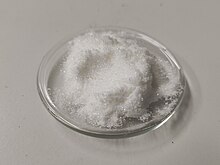Ethylvanillin

| |

| |

| |
| Names | |
|---|---|
| Preferred IUPAC name
3-Ethoxy-4-hydroxybenzaldehyde | |
| Other names
Bourbonal
| |
| Identifiers | |
3D model (JSmol)
|
|
| ChEBI | |
| ChEMBL | |
| ChemSpider | |
| ECHA InfoCard | 100.004.059 |
| KEGG | |
PubChem CID
|
|
| UNII | |
CompTox Dashboard (EPA)
|
|
| |
| |
| Properties | |
| C9H10O3 | |
| Molar mass | 166.176 g·mol−1 |
| Appearance | Colourless powder |
| Density | 1.186 g/mL |
| Melting point | 76 °C (169 °F; 349 K) |
| Boiling point | 295.1 °C (563.2 °F; 568.2 K) |
| Slightly soluble in water | |
| Hazards | |
| Occupational safety and health (OHS/OSH): | |
Main hazards
|
Harmful, irritant |
| GHS labelling: | |

| |
| Warning | |
| H319, H402 | |
| P264, P273, P280, P305+P351+P338, P337+P313, P501 | |
| NFPA 704 (fire diamond) | |
| Flash point | 145 °C (293 °F; 418.15K) |
Except where otherwise noted, data are given for materials in their standard state (at 25 °C [77 °F], 100 kPa).
| |
Ethylvanillin is the organic compound with the formula (C2H5O)(HO)C6H3CHO. This colorless solid consists of a benzene ring with hydroxyl, ethoxy, and formyl groups on the 4, 3, and 1 positions, respectively. It is a homologue of vanillin, differing on the 3 position.
Preparation
[edit]Ethylvanillin is prepared from catechol, beginning with ethylation to give guaethol (1). This ether condenses with glyoxylic acid to give the corresponding mandelic acid derivative (2), which by oxidation (3) and decarboxylation, gives ethylvanillin (4).[1]
Application
[edit]As a flavorant, ethylvanillin is about three times as potent as vanillin and is used in the production of chocolate.[1]
The molecule revolutionized both the design and aesthetics of olfactory art; artist Jacques Guerlain added a large quantity of it to a bottle of Jicky (1889) perfume, creating the main accord for the perfume house's flagship fragrance, Shalimar (perfume) (1925). This is one of the earliest uses of synthetic molecules that freed scent artists from the limits of natural materials.[2]
References
[edit]- ^ a b Karl-Georg Fahlbusch, Franz-Josef Hammerschmidt, Johannes Panten, Wilhelm Pickenhagen, Dietmar Schatkowski, Kurt Bauer, Dorothea Garbe, Horst Surburg "Flavors and Fragrances" in Ullmann's Encyclopedia of Industrial Chemistry, Wiley-VCH, Weinheim: 2002. Published online: 15 January 2003; doi:10.1002/14356007.a11_141.
- ^ "Vanillin:Molecule of the Month". Bristol University.


